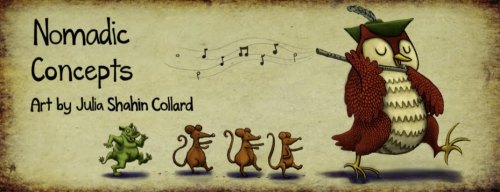
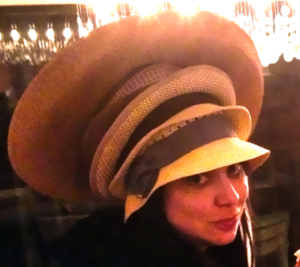 As you can see Julia Shahin Collard wears a lot of hats. When not illustrating or writing for kids, Julia can be found herding cats, telling puntastic “jokes,” or beating kale. (Yes, beating, not eating. Kale is a Collard’s natural enemy.) She may or may not be part narwhal.
As you can see Julia Shahin Collard wears a lot of hats. When not illustrating or writing for kids, Julia can be found herding cats, telling puntastic “jokes,” or beating kale. (Yes, beating, not eating. Kale is a Collard’s natural enemy.) She may or may not be part narwhal.
Julia Shahin Collard’s art has been published in the Los Angeles Times, as well as exhibited in the Venice Art Walk and other shows. She was honored to have a solo art show at Villa Musica in San Diego in 2013. In February 2014, she was selected as SCBWI’s Featured Illustrator, and was the OC Illustrators’ Featured Artist in May 2014.
ACRONYMS:
– BFA in Film & TV Production from NYU = screenwriting, storyboarding & visual storytelling experience.
– MBA in Art Management & Finance from UCLA = professional attitude; will meet deadlines.
– Member of SCBWI: Lifelong desire to write and illustrate books = drive and internal motivation.
Here is Julia explaining her process:
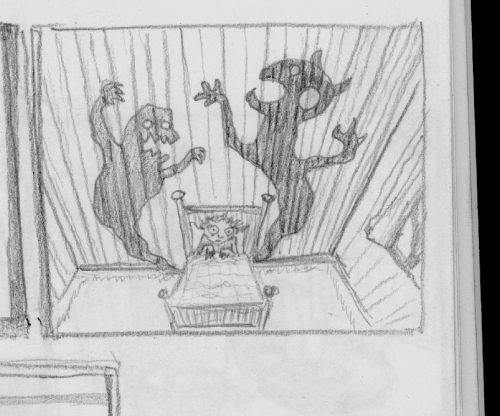
I draw the scene in its final size with a more refined line, but it’s still pencil on paper. I scan it, and clean it up in Photoshop. I lock the transparency of the sketch so I can change the color of the pencil lines if I want to, but I usually like to keep a dark outline.
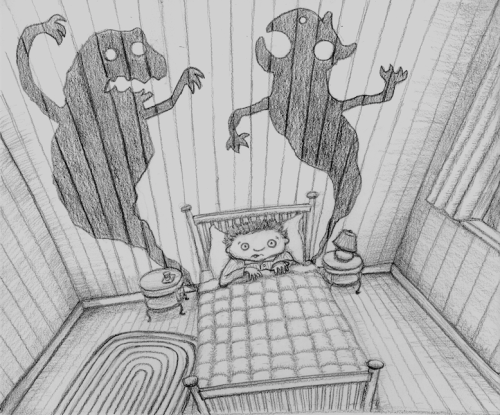
I start with a thumbnail sketch. I keep a whole list of images I have in my mind that I’m interested in drawing, and whenever I get a chance, I start working my way through them. If one of them looks like it would be interesting to flesh out, I take it to the next step.
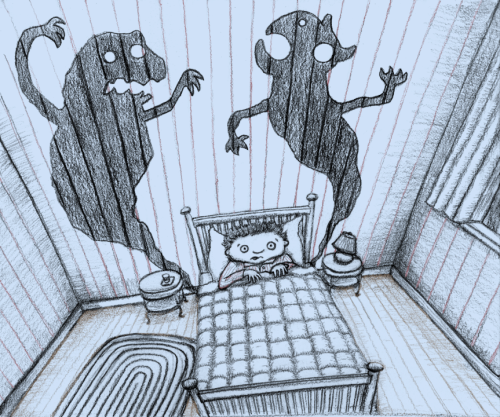
I begin to add in color. First I add an overall “wash” and place it underneath the pencil layer.
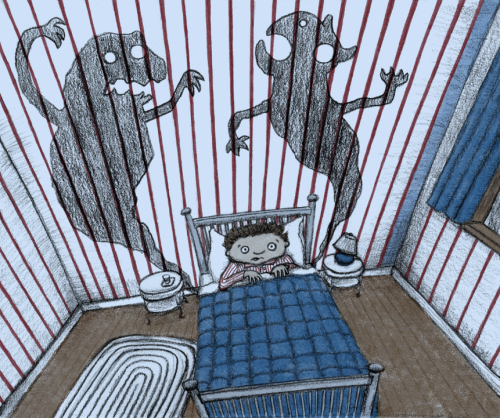
Then I add in the principal bits of color, using a “Multiply” layer.
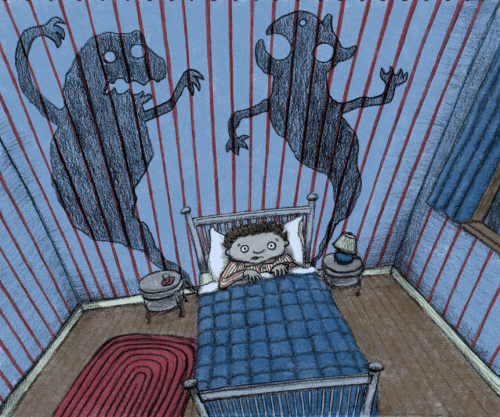
If I’m lasso-ing sections and filling in with color, I’ll sometimes do that on a separate layer for ease of use. Ultimately, I have colored in everything that needs color, added some depth of color on top of previous layers of color, and now the painting bit comes more into play in the next step.
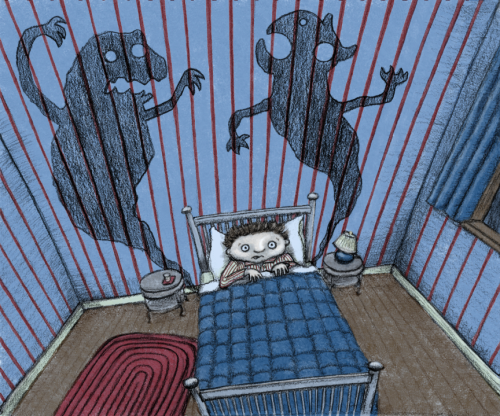
Here I’ve added lights using a “Screen” layer. What’s great about Photoshop is that you can do this at any time, and layer it in wherever you want to achieve the desired effect.
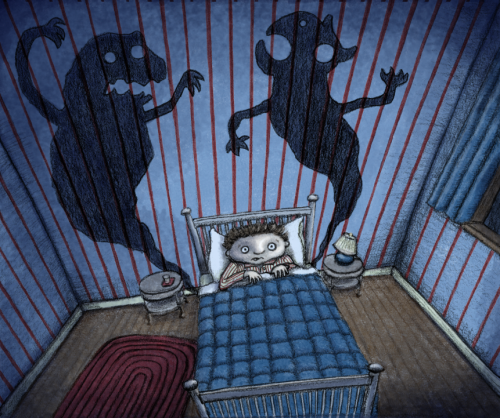
And now I work with the value – I make sure my darks are dark enough all over the painting. Also, since this is a moody night scene, I painted in a vignette effect to help set the scene and focus the viewer’s eye on the boy.
After all this is done, I will sometimes tweak the exposure or other overall elements of the piece so that the image “pops” more. I really want my darks to be dark and my lights to be light – I think my shift to treating my illustrations as paintings – and focusing on value and depth of field – is what has made my work cross the tipping point over to unique and ultimately, worthy of publishing.
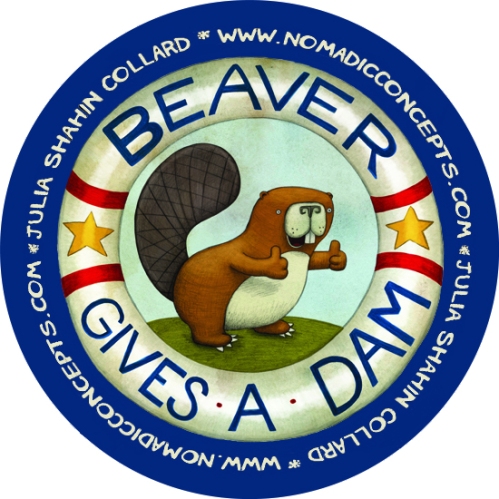
How long have you been illustrating?
I’ve been drawing for as long as I can remember, but I finally made the leap to make it a career in 2009, when I attended my first SCBWI conference.
– Writing since eight years old
– Illustrating since 10 (won some contests, submitted to Cricket Magazine, etc…)
– Wrote and illustrated first ‘Children’s Book’ at 11 years old, “The Foot That Crunched LA”
– Wrote my first full-length book at 21. (And, oh, I thought I was so clever! Adverb this, and adjective that, blah, blah)

What was the first thing you created where someone paid you for your work?
This is a hoot, but it was a painted leather drum, created for some sort of hippie cleansing festival. It must have been in 2008, because it’s not on my blog.
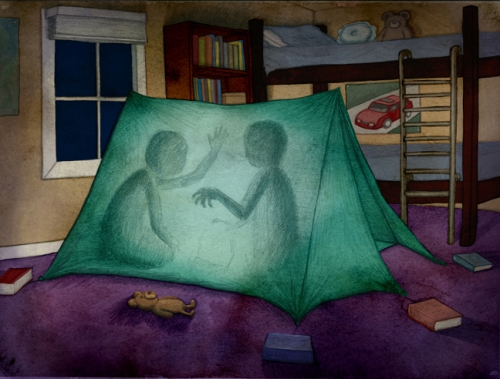
Did you live in NYC when you decided to attend Film & TV Production from NYU?
I lived in NYC for four years while attending NYU for my BFA, arriving when I was just 17, and boy, did I have culture shock! Living in the city was exciting, but it was also hard. Ultimately, it was the weather that did not agree with me. As a SoCal native, I just couldn’t get used to the weather extremes, and I missed having green trees all around me at all times.

Do you think getting your BFA helped you develop as an illustrator?
While at film school, I endlessly wrote screenplays and storyboarded scenes in preparation for production. Even though it wasn’t for children’s books, the process definitely helped me craft my storytelling voice and develop scene pacing. Storyboarding also helped me determine which bits of action in each scene were the most important to show – something that directly translates to crafting images for children’s picture books.
I didn’t really think that I could pursue children’s book writing and illustration – art was never something that was really supported by my family. I was lucky enough to have a father who was willing to pay my college tuition, but he refused to let me major in the arts…until I managed to convince him that the film business wasn’t just about art, it was about making deals and so on. But this fear of art had already been instilled in me – I never took a painting or drawing class after I won an award in art class in 8th grade. My father was very uncomfortable with what was obviously my passion, and I guess I was hungry for his approval. So from the age of 13 to 21, I didn’t take a single drawing or painting class, even though I absolutely could have.
It was around the age of 18 that I realized that I wasn’t over my bugaboo about making books. So in between films and class commitments, I would write, paint, and bind my own little books. They are all terribly self-important and just plain terrible. I was truly convinced I was good enough without formal training. I look at what I made almost 20 years ago, and I cringe. I didn’t know a thing.

What types of classes did you take that really helped you to develop as an illustrator?
Before and after Business School at UCLA, I signed up for their summer programs – they offer an Advanced Painting class that anyone can take with instructor consent, even people who aren’t matriculated at UCLA. I had 24-hour access to a studio for the whole summer. I ended up taking the class three times, each time with a different instructor. I think it was there that I really learned to tell stories in my imagery. It wasn’t from any particular instruction – since it was Advanced Painting, they didn’t actually teach us any fundamentals, they would just prod us to move in certain directions.
But I still didn’t have the basic training – drawing nudes and still lifes. I had put it off long enough. So I signed up for a long succession of fundamental classes in drawing and painting at UCLA Extension.
In 2008, I signed up for my first children’s book writing and illustration class. It was taught by Barney Salzberg at UCLA Extension. I went in thinking I was going to own this thing. Of course, I look now at the stuff I was making then, and it’s horrible. My style seemed based on 1980s picture books, which are NOT what sell now.
Other than that class, there weren’t any at UCLA that focused on illustration in a studio setting – I did manage to take a graphic novel class at SMC, and a couple classes at Art Center (one on graphic novels, and another on composition), but I pretty much used up all the available resources LA’s colleges had to offer. That’s when I joined SCBWI.
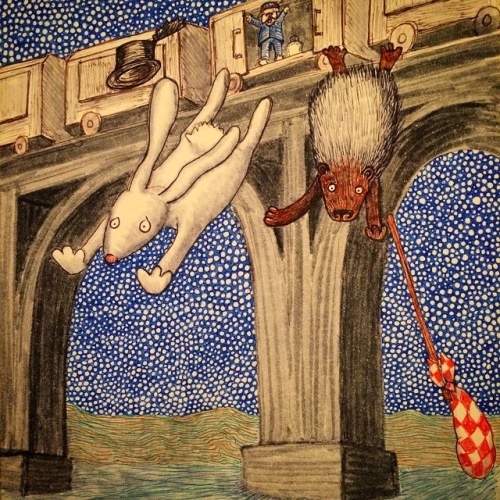
What inspired you to move to California and get your MBA in Art Management & Finance from UCLA?
As soon as I graduated college, I was selected to go to France to do an internship through Kodak at the Cannes Film Festival, and from there, I traveled around the world for six months. The stipulation from my dad (I know, him again) was that for him to fund this trip extension, I needed to agree to move back to LA. So I did.
Back in LA, I worked a bunch of grunt jobs in the film industry out here for a while, until one day, after coming home from a long brain-festering day of answering phones, Xeroxing scripts, and writing coverage, I decided I was meant to do more with my life than wait in line at the bottom of the heap with a million other people desperate to work for beans. I learned while in film school that I wasn’t a fan of production, but preproduction didn’t seem to be doing it for me either. At least not the bottom rungs. I didn’t get to create anything, and I wasn’t even able to use my mind. I needed to find a different way “in.” I saw how many people on the business side of the film industry just transitioned into production after working in marketing and strategy for however many years. It seemed like it would at least be more interesting than Xeroxing and at most be my shortcut to the top of the ladder, and gave me a Plan B – something to do with my life in case it wasn’t in the cards for me to become the head of a major studio. (Remember, I was fresh out of college, so I really thought I could do these things, and still be able to quit it all to work on kid’s books at the age of 35)
But first I needed some real job experience. So I took some classes in statistics and accounting, got a job in finance, and learned to love Excel and accounting for a year. And voila, I got into my top choice school. Why was UCLA’s Business School my top choice? Because they had an Art & Entertainment Management track, unlike any of the other schools I looked at. You see how hard I was contorting myself to get to a place where I could be creative.
While I was at UCLA, I learned the ins and outs of starting my own company. Something that has been invaluable in my tax planning and long-term financial strategy in my illustration career. Granted, it has taken longer than I had initially projected (To be honest, I gave myself two years – HA! Wishful thinking.)
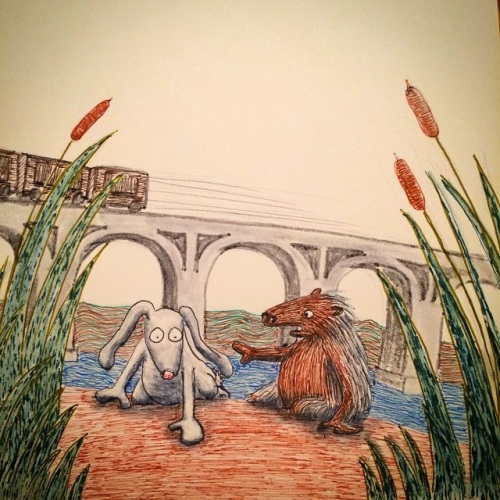
Did you want to be an illustrator when you attend UCLA?
As I told my husband when we first started dating (we met at UCLA), “I’m going to work now, and build up something to make compound interest on, but by the time I am 35, I want to be writing and illustrating children’s books as my job.”
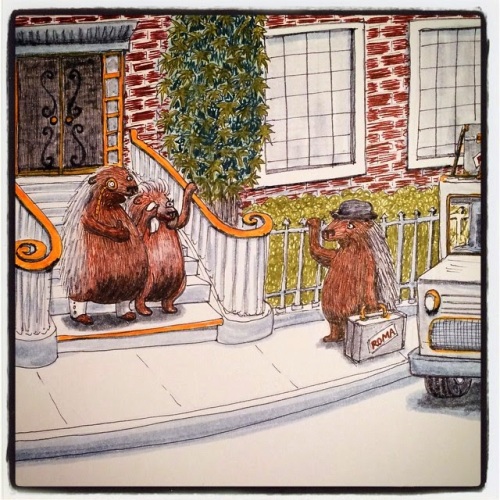
What did you do right after you graduated?
Post-B-School, I found myself back working in finance, unable to snag the dream job I had worked so hard to get. I came close in interview rounds multiple times, but something just wasn’t getting me the job. Maybe it’s that they knew my heart wasn’t in it. I just wanted to create. Enter the SEISMIC SHIFT.
One of my dad’s good friends took me aside one day at dinner and asked me while I wasn’t pursuing art. He knew me when I was young, and how passionate I was about making art. What had happened? And I told him all the things I had been indoctrinated with – how I needed to make a living, how artists leech off of other people, and how I was too smart for it all (I was fed these lines)
The next week, I was randomly going through an art supply catalogue (I’d been taking those painting classes at UCLA and UCLA Extension on the side, after all), and on the phone with my sister. She told me to make a wishlist of art supplies, so that she could get me something for my birthday. But to just circle everything that I could ever want.
A few weeks later, a small truckload of boxes arrived at my apartment. My dad’s friend had purchased ALL of the supplies I’d put on my wishlist. EVERY LAST ITEM. Even a super-ridiculous easel. He said if my dad wasn’t going to support me, he would. He knew that I had innate talent and I was wasting myself. All I needed were the supplies – the motivation was more than there. And like that, he was gone – I didn’t see him for a couple of years.
God. Do I KNOW how lucky I am to have had this man sweep into my life like that. Talk about fairy godparent. I didn’t go back to finance. I told my boyfriend (now-husband) that I NEEDED to try. Just give me two years, I asked. If I don’t make it, I’ll go back to finance. I had savings. Being a starving artist didn’t cost much.
It took him a while to warm up to the idea. After all, why did I even go to business school if I was just going to throw in the towel like that? It was something that nagged at me for the first five years, when I was still pretty bad at illustrating, and was still piecing ramen money together by painting people’s pets – because after all, I’d basically had no art training. But I felt ALIVE. That familiar FLOW STATE came flooding back to me, and I made and made and made and made…like a dam had burst.
And yes, it was amateur work. But I had to start somewhere. And I had no doubt that I could improve. If I put my mind to something, I could do it. After all, I was a BFA who managed to get into a Top 20 Business School. They all thought I was an outsider there too. So at least I was used to the feeling of “other” when I walked into art classrooms and was conspicuously older than everyone else.
And so, to finally answer the question: I endeavored to build fine art portfolio before undertaking the writing/illustrating.
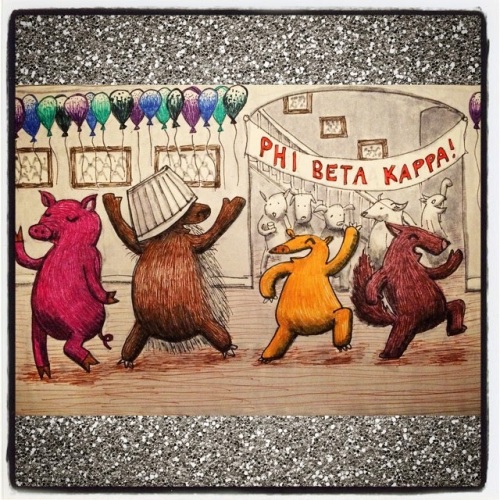
When did you decide that you wanted to illustrate for children?
I’d been making my own children’s books since the age of 11, and I was 18 when I decided that it was eventually what I wanted to end up doing for the bulk of my life.
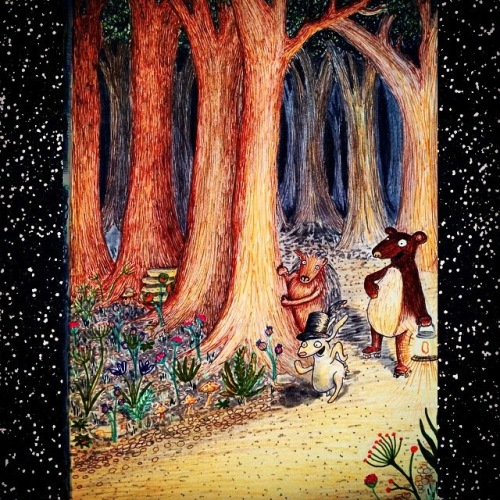
How did you get to do the LA Times artwork?
In May of 2011, I emailed the editor of the Kid’s Reading Room section of the Los Angeles Times (I had received her information from a colleague), with a link to my portfolio, asking if she would consider me for a piece. The editor emailed back with interest, and from there, it was just a waiting game for the right project. Three months later, I got a call from her asking if I’d be interested in illustrating a Halloween story. I had a month to come up with rough sketches, go to final sketch, and then final art. A month after that, the story ran! Woo-hoo!
Unfortunately, the Kids’ Reading Room was cut by Corporate in March of 2012, so I didn’t get a chance to try again.
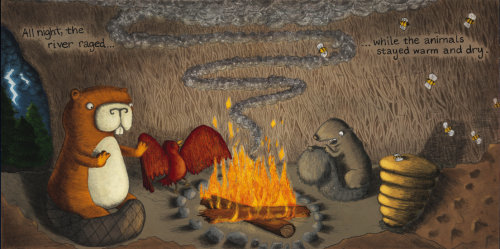
Have you tried your hand in licensing art?
It’s not something that I have actively pursued. On occasion, I’ve been asked a price to license a certain image, but usually they shy away when I tell them the price (which is directly from the Graphic Artist’s Guild price guidelines, so I’m not being out of line or anything).
I do sell my work on print-on-demand websites like Zazzle and Fine Art America, but that’s not licensing.
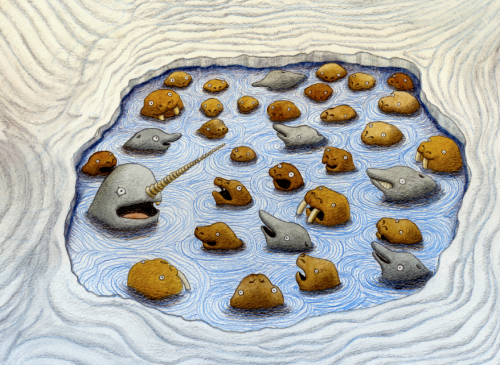
Since I know you attend the SCBWI conferences, do you show off your portfolio at the conference?
Whenever I attend a conference, I always make a point of entering my work in the portfolio showcase. Other than that, I don’t typically take it out unless people ask to see it. Even then, I find it a lot easier to pass around my picture book dummies, since they are smaller, and writers seem to understand what they’re looking at better.
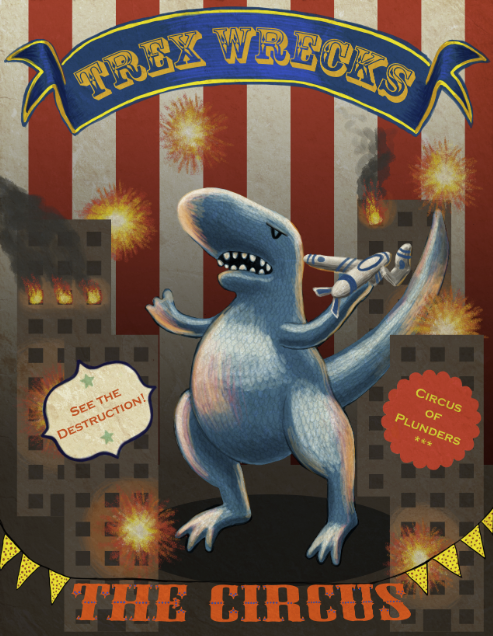
How did you connect with Lara at Andrea Brown Literary Agency?
I have a whole blog post with the details, but long story short, Steven Malk recommended that I talk to one of the agents at Andrea Brown, so I met Kelly Sonnack and queried her, and she replied saying she was about to have a baby but she sent my book dummy to her colleague Lara Perkins, and Lara loved it and wanted to talk on the phone. Lucky, lucky, lucky. I am so lucky that Lara was brought into the picture – she is the perfect fit for me.
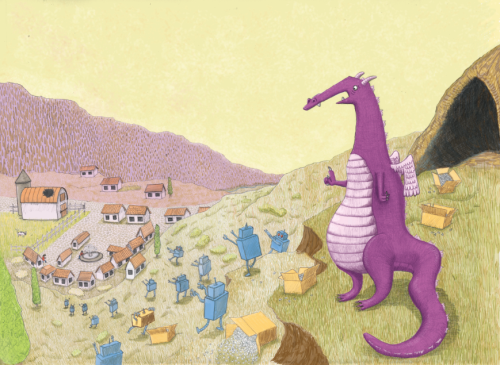
Do you have any desire to write and illustrate your own book?
Yes, I tend to think of myself as an author/illustrator primarily, but I am happy to work on other people’s stories if the opportunity arises.
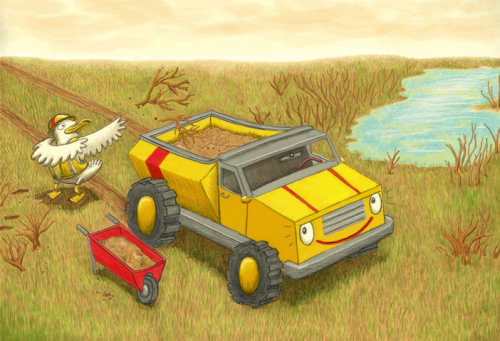
Do you think your style has evolved since you attended college?
Well, haha, considering the fact that I didn’t really HAVE a style in college, I’m gonna have to say yes. 😉
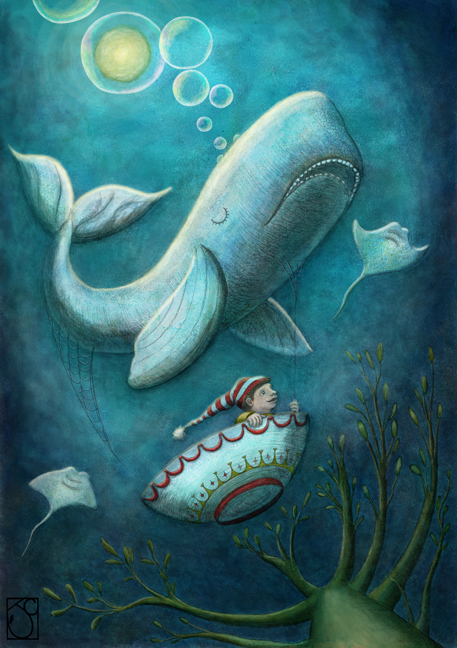
Do you use Photoshop in any of your work?
All the time. My current working method is heavily computer-based – I draw with pencil on paper, scan it into the computer, and fully paint it in Photoshop.
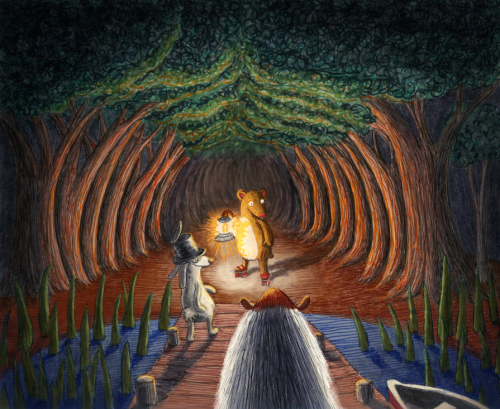
Would you consider working with an author who wants to self publish?
I would ask them to contact my agent and she would work out the details.
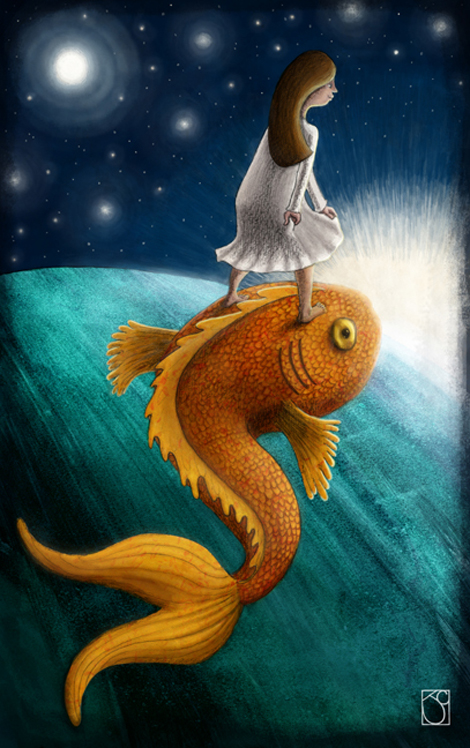
Have you worked with educational publishers? If so, which one’s?
No, I would prefer to work for a royalty rather than a flat rate, if at all possible.
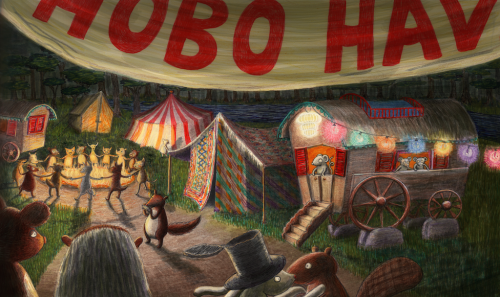
Have you done any artwork for magazines?
Just Kite Tales Magazine, the SoCal Triregion magazine for SCBWI.
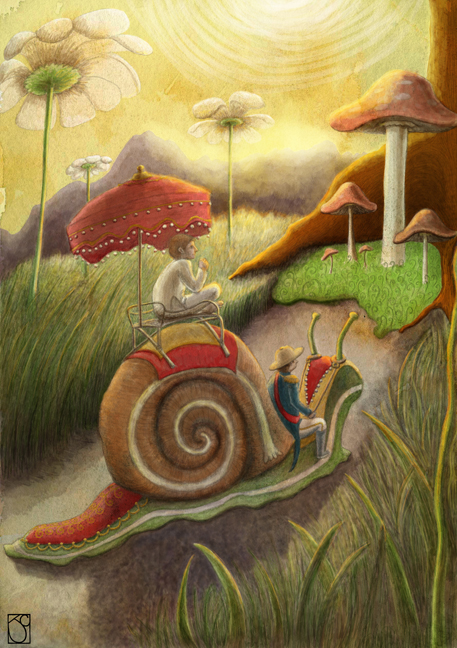
Do you do any types of promotion on your own to get your work seen by publishing professionals?
Once a quarter, I send out a postcard mailing to the art directors at publishing houses, as well as select editors.
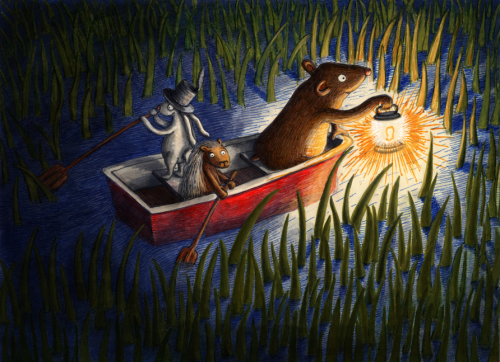
Have you gotten any work through networking or the Internet?
Definitely networking. Most of the people who find me through the internet contact me about books they want to self-publish, and they never want to pay the Graphic Artist’s Guild rate.
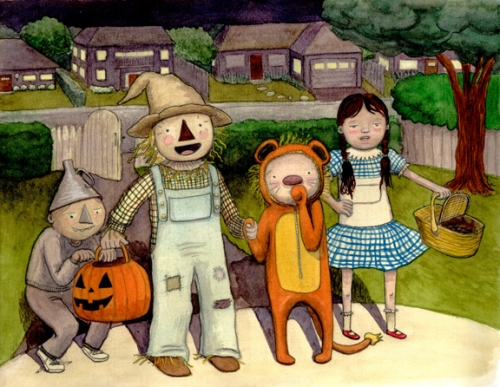
Do you use software for painting like Photoshop or Painter?
I use Photoshop. I’d love to be able to use Adobe Illustrator too, but the last time I took a class on it was in 2000, and I didn’t keep up with it. I tried using it a couple years ago, and it’s a whole different beast now. I’m sure if I hadn’t been using Photoshop continuously through the software upgrades, I would have been unable to use it as well. I’ve tried using other programs as well, but nothing has felt as comfortable as Photoshop.
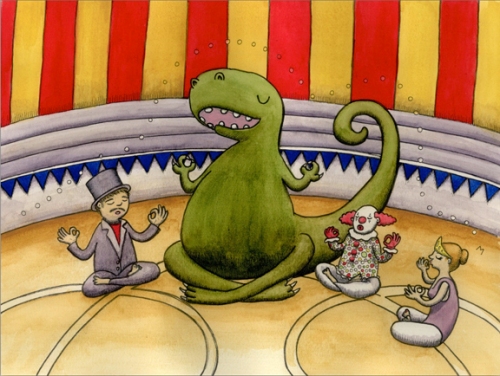
Do you own a graphic tablet? If so, how do you use it?
I have a 24-inch Wacom Cintiq, and it has become indespensible in my artwork. I do an initial pencil sketch, scan it in, clean up the black and white image, and then GO – I paint everything on the computer.
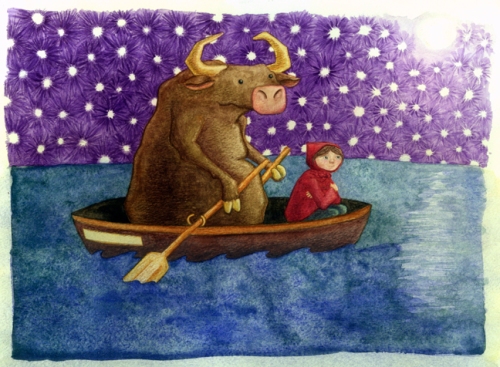
How much time do you spend illustrating?
It depends on what I’m working on. If I’m painting, then I’m doing it all day long. I just get lost in it. Total flow state. If I’m doing initial compositions or storyboarding, that’s a lot more frontal lobe work, and I need to take lots of breaks.
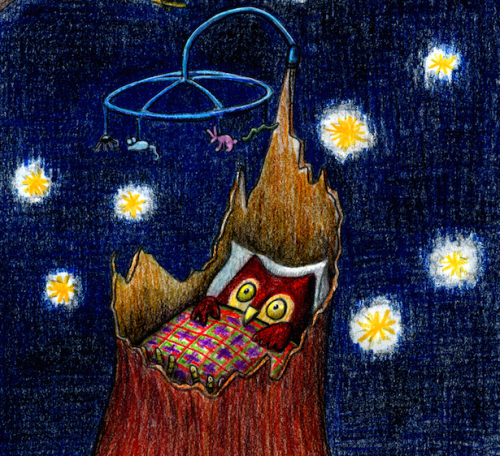
Do you have a studio set up in your house?
I had a separate art studio up until the end of last year, when my art style almost 100% moved onto the computer, and I was spending most of my days with my 70 lb Wacom at home. I have a spare bedroom set up as my “laboratory” where I am surrounded by books and piles of papers and inspirational objects.
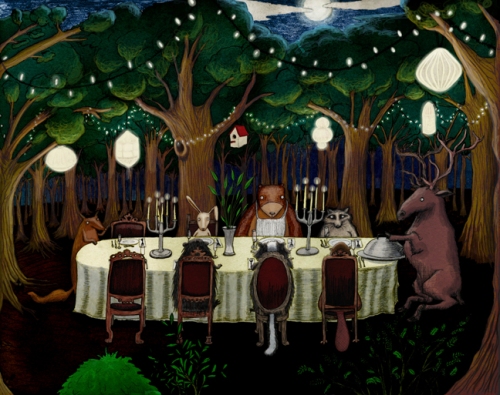
Do you have a strong art community where you live?
With LA being so spread out, most of my friends near me are writers. The illustrators tend to congregate further east. I see at least one of my writer friends every week, it seems, but it’s usually a special event that brings the illustrators together. Today, for example, we got together to celebrate Dan Santat’s Caldecott win. Lots of people came in from all around to congratulate him, and we all talked about how we should be getting together more often.
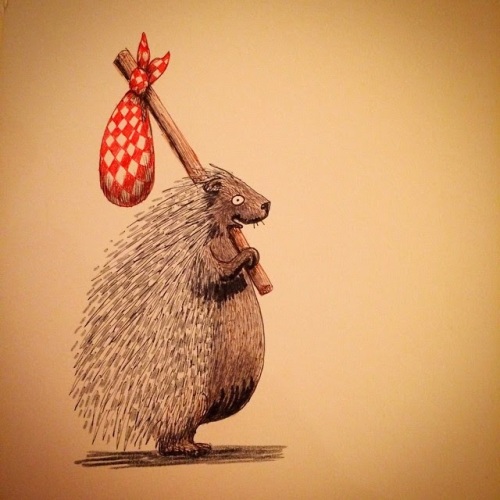
What are your career goals?
I always believe in reaching far for things that don’t seem possible in the here and now, so I’m going to be honest and say that my career goal is to win a Caldecott.
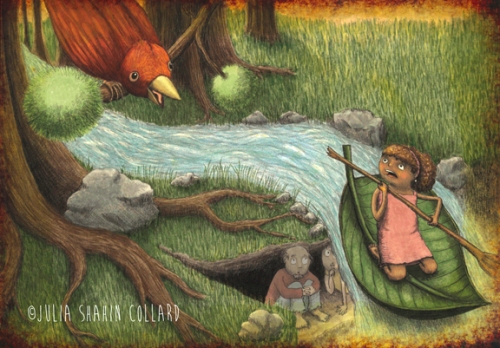
What are you working on now?
I’m working on another picture book dummy, but I’m supposed to be pretty tight-lipped about it, so I’m zippin’ it!
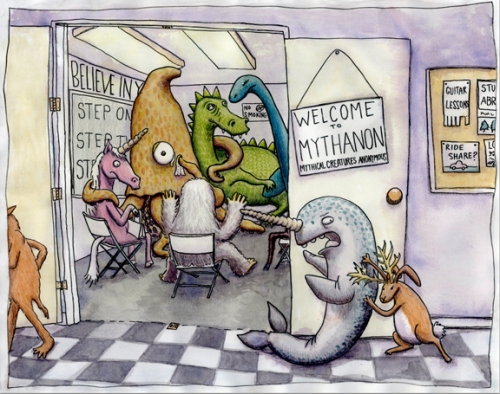
Are there any painting tips (materials, paper, etc.) you can share that work well for you? Technique tips?
Layers, layers, and more layers in Photoshop – tweak the transparancy and try using “multiply” – treat it like a painting, because…it is a painting! That’s how I managed to make things look less digital, anyway.

Any words of wisdom you can share with the illustrators who are trying to develop their art career?
Be patient. If you stick with it long enough, your ship will arrive.
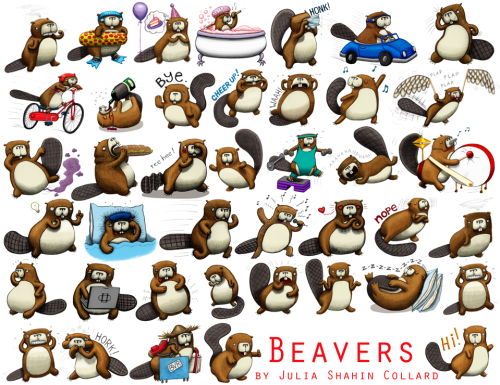
Thank you Julia for sharing your talent, process, and journey with us. Please make sure you keep in touch and share your future successes with us. Website: http://nomadicconcepts.madewithcolor.com/
If you have a minute, please leave Julia a comment. I am sure she would love it and I enjoy reading them. Thanks!
Talk tomorrow,
Kathy
Thank you for interviewing me, Kathy!
LikeLike
By: Julia Shahin Collard on February 21, 2015
at 11:19 am
Hi there. I’ve gotten a bit of feedback since the interview came out, so I just wanted to add a note to clarify my process.
In case anyone was confused by the juxtaposition of ink line drawings with my statement that I work almost exclusively digitally: Quite a few of the images shown throughout the interview are actually daily sketches that I did for Inktober in 2014 (just a little story I made up for myself about a Hobo Porcupine) – and they are just camera phone photos of the ink on paper – which is not the process I usually use for my finished art. When answering the interview questions, I didn’t know which pieces were going to be shown, and I answered based on the technique I use in my final art for picture books. What I have in my online portfolio is primarily digital work, and those images are towards the bottom of the interview.
Sorry for any confusion and thanks for reading!
– Julia
LikeLike
By: Julia Shahin Collard on February 22, 2015
at 6:30 pm
Really love your work . . . thank you for taking us through your process and your journey. I opted for the traditional business route and then redirected to painting and writing . . . hearing your success is inspiring. May all your dreams come true!
LikeLike
By: helennhill on February 22, 2015
at 8:29 pm
Yours too, Helen! Thanks so much for reading and commenting! It’s heartening to know I’m not the only rerouter out there! 😀
LikeLike
By: Julia Shahin Collard on February 23, 2015
at 2:35 pm
Another great post, Kathy. Julia is so talented and it is so generous of her to share her pictures and stories.
LikeLike
By: Kaye Baillie on February 23, 2015
at 1:39 am
Thank you so much for reading and commenting, Kaye!
LikeLiked by 1 person
By: Julia Shahin Collard on February 23, 2015
at 2:36 pm
Love your story and your art!
Thank you.
LikeLike
By: Carleen M. Tjader on February 23, 2015
at 7:58 pm
Thanks for reading and commenting, Carleen! 🙂
LikeLike
By: Julia Shahin Collard on April 6, 2015
at 2:15 pm